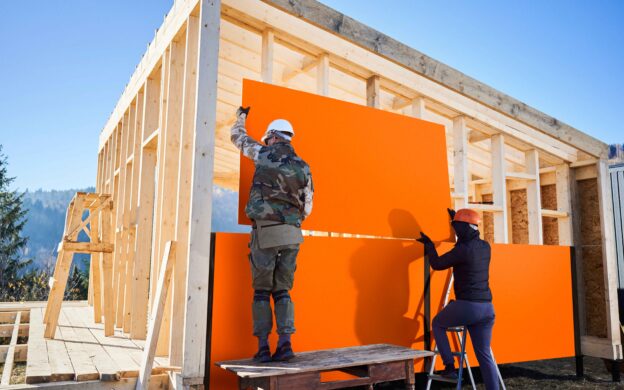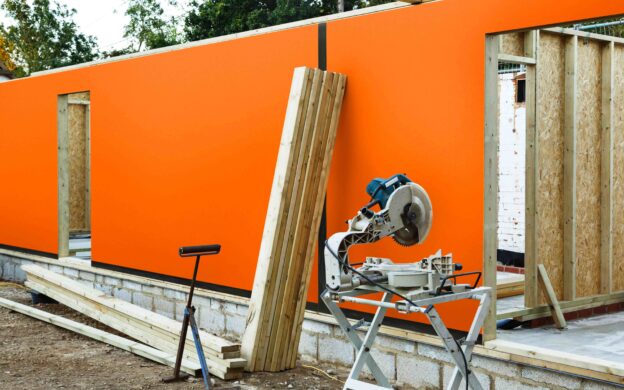
To use a comparison, OSB can be mechanically as strong and durable as some plywoods. Using strands of veneer in panel production means there are no defects in the panel as seen in plywood, like knots or core voids. The use of strands also allows for OSB to be manufactured in larger sizes. Some types of OSB, such as OSB3 and above, have a level of water resistance. To retain their structural integrity in certain applications, the boards must additionally be weather protected.
There are various options for the weatherproofing of an OSB. Traditional waterproofing membranes and paints can be applied to protect the OSB, but their application is a relatively slow process and if done on site, the installation is weather dependant. Arctek performance overlay technology by Arclin is a high-performance overlay solution that forms a weatherproof barrier when thermally fused with the OSB. This is done during the manufacture of the board and once the weatherproofed OSBs are on site, they are ready to be installed.
How is OSB used in modern buildings?
OSB has been used for decades as sheathing for walls and roofs in North America, but it is also a popular choice in Europe and Scotland. As we move towards more energy efficient, sustainable buildings and a higher level of building component prefabrication, OSB is becoming increasingly more utilised.
These lightweight, strong boards are used for the manufacture of modern building components such as structured insulated panels (SIPs), wall and roof cassettes. These are high performance components premanufactured to the structural, thermal and design requirements of a specific project. Whether this is an open wall cassette that consists of OSB sheathing and a timber frame, or a complete wall cassette with door and window openings, insulation layer and mechanical and electrical components preinstalled, they are then delivered to the site, ready to install.
OSB manufactured building components can form structural external or internal walls or infill walls. They can also be specified for roofing and flooring, facades and various external decorative applications.
What are the benefits of OSB in residential construction?
OSB is a durable and sustainable material that can help improve the performance of buildings and comes with many benefits including:
- Versatility and low weight
- Strength and rigidity
- Limits heat transfer and airborne noise
- Increased building energy efficiency
- Cost-effectiveness
- Sustainability
Consideration should be given to the performance of OSB in humid conditions. We already touched upon the ability of OSB rated 3 and above to withstand moisture exposure, however, the board should not be exposed to weather without a weatherproofing membrane.
How can the performance of OSB be improved?
As we already discussed earlier, weatherproofing of OSBs is one of the strategies that can significantly enhance their performance. We also talked about the efficiency and effectiveness of installation of waterproofing membranes versus the use of Arctek performance overlay technology overlay solutions.
Arctek overlays can also help smooth the surface of the OSB board without the need for laborious sanding. The result is a homogenous surface that is ready for painting. The overlay can also act as a primer that makes the installation of subsequent layers easier and increases the compatibility of the OSB with adhesives used for finishing works.
To find out more information on how Arctek performance overlay technology, from Arclin, can improve the performance of OSBs used in modern house building, or to discuss the technology and its benefits in more detail, contact us.


